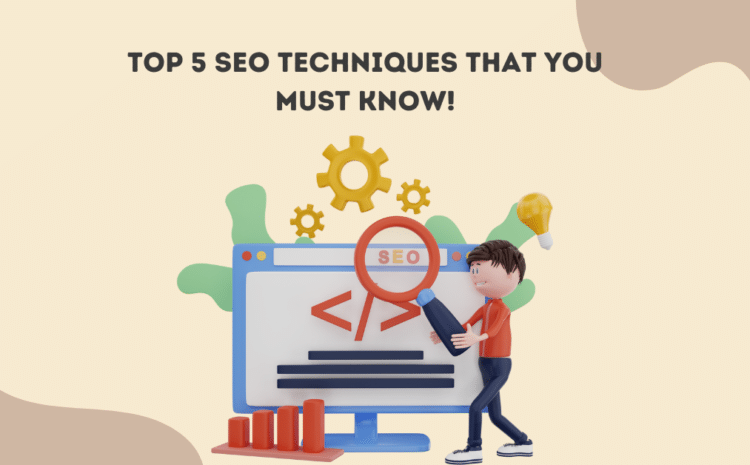Top 5 Seo Techniques That You Must Know!
Top 5 SEO Techniques 2023
Introduction:
SEO techniques are a critical element of digital marketing that helps websites rank higher in search engine results, gain visibility, and draw organic traffic. While the domain of SEO is continuously evolving, certain techniques are proven to be useful in improving search engine rankings.
If you were searching the web for “what are the types of SEO techniques“, here is your answers. In the following points, we will discuss the top five Search Engine Optimization Techniques or SEO techniques that can help promote your website’s visibility and drive more organic traffic.
What Are The Types Of SEO Techniques That Help Promote Your Website?

SEO Techniques #1: Keyword Research and Optimization:
Keywords are the basis of any successful SEO strategy. Keyword research is the process of specifying the terms and phrases that the target audience uses when looking for products or services identical to what you offer. By incorporating these keywords intrinsically throughout your website’s content, including titles, H1s, H2s, meta tags, and body text, you can optimize your site for suitable search queries. However, it’s important to maintain a balance and avoid keyword stuffing, as search engines may penalize websites for the overblown use of keywords.
SEO Techniques #2: High-Quality Content Creation:
Developing high-quality, relevant, and engaging content is vital for SEO success. Search engines prioritize websites that provide value to users, so concentrating on content that educates, entertains, or solves a difficulty is crucial. Well-written articles, blog posts, infographics, videos, and other forms of content can draw links from other websites, enhance user engagement metrics, and enhance your site’s authority. Additionally, regularly updating your content and addressing user queries can signal freshness and boost your rankings.
SEO Techniques #3: On-Page Optimization:
On-page optimization refers to optimizing the elements within your web pages to enhance their search engine visibility. This comprises optimizing meta tags (title tags, meta descriptions), headers (H1, H2, etc.), URL structures, and image alt tags. Ensuring that your web pages load quickly, are mobile-friendly, and have clear site navigation can also improve the user experience, leading to better rankings. By enforcing structured data markup, you can also make it more effortless for search engines to understand your content and exhibit rich snippets in search results.
SEO Techniques #4: Link Building:
Link building is a noteworthy factor in SEO. It concerns acquiring high-quality backlinks from other reputable websites. Search engines view backlinks as votes of confidence, indicating that your website offers useful content. However, it’s important to concentrate on quality over quantity. Building links from authoritarian and relevant sources can thoroughly impact your search rankings. Some effective link-building approaches include guest blogging, influencer outreach, content promotion, and creating link-worthy content that naturally attracts backlinks.
SEO Techniques #5: Technical SEO:
Technical SEO concentrates on optimizing the technical aspects of your website to improve its crawl ability, indexability, and overall performance. This comprises optimizing website speed, fixing broken links, enhancing URL structure, enforcing XML sitemaps, and assuring proper canonicalization. By making your website technically sound, you deliver a better user experience and make it easier for search engine crawlers to access and understand your content, resulting in improved rankings.
Diving Deeper Into Offpage and Onpage SEO Methods
On-Page SEO methods refer to the techniques implemented directly on a website to enhance its search engine rankings and visibility. This comprises optimizing content, meta tags, URLs, and internal linking. On-page SEO involves creating high-quality, relevant, and engaging content that aligns with targeted keywords and user intent. It also includes optimizing page titles, meta descriptions, and headings to make them keyword-rich and appealing to users in search engine results.
Off-Page SEO methods, on the other hand, focus on improving a website’s reputation, authority, and visibility through external factors. It involves activities performed outside the website to boost its ranking in search engine results. This includes building high-quality backlinks from reputable websites, social media promotion, guest blogging, influencer marketing, and online community engagement. Off-page SEO methods aim to increase the website’s popularity and credibility, signaling to search engines that the site is trustworthy and valuable.
Both on-page and off-page SEO methods are crucial for a comprehensive search engine optimization strategy. While on-page SEO methods ensure that the website is well-structured, optimized, and user-friendly, off-page SEO methods help to establish the website’s authority and relevance in the online ecosystem. Both techniques work together to improve search engine rankings, drive organic traffic, and increase the website’s visibility and exposure to a wider audience.
To achieve optimal results, it is important to focus on both on-page and off-page SEO methods, continually analyzing and adjusting strategies based on search engine algorithms and user behavior. By implementing a well-rounded SEO approach, websites can enhance their online presence, attract more visitors, and ultimately achieve their goals.
Distinguishing Features Of A Website That Utilizes Smart SEO Techniques

A well-optimized website stands out from others due to several key factors. Here are some of the distinguishing features of a well-optimized website:
Fast loading speed:
One of the most essential factors is fast-loading speed. A well-optimized website is designed to load quickly, ensuring a smooth and seamless user experience. Slow-loading websites tend to frustrate visitors and can result in higher bounce rates.
Mobile responsiveness:
With the growing use of mobile devices, a well-optimized website is responsive and adjusts its layout and content to fit different screen sizes. Mobile responsiveness improves user experience and ensures that visitors can access and navigate the website effectively on any device.
On-page & Off-page SEO techniques:
Well-optimized websites implement SEO techniques to improve their visibility in search engine rankings. They incorporate relevant keywords, meta tags, and defining URLs, and follow the best methods for on-page and off-page SEO techniques. This helps attract organic traffic and improves the chances of appearing on the first page of search engine results.
User-friendly navigation:
A well-optimized website has intuitive and user-friendly navigation. Visitors should be able to easily find the details they need and navigate between different pages without perplexity. Clear menus, a logical site structure, and a search function contribute to a positive user experience.
High-quality and engaging content:
Content plays a crucial role in website optimization. Well-optimized websites provide high-quality, relevant, and engaging content that meets the needs and interests of the target audience. This not only attracts visitors but also encourages them to stay longer, explore further, and potentially convert into customers or take desired actions.
Integration with analytics:
Well-optimized websites incorporate web analytics tools such as Google Analytics to track and measure various metrics. These analytics provide valuable insights into website performance, user behavior, and conversion rates. By analyzing this data, website owners can identify areas for improvement and make informed decisions to optimize their sites further.
Properly optimized images and media:
Images and media files should be appropriately optimized to minimize file size without compromising quality. Compressed images and optimized media files reduce page load times and improve overall website performance.
Integration with social media:
Well-optimized websites often integrate with social media platforms, allowing users to share content easily. Social media integration helps expand the reach of the website’s content and drives more traffic.
Takeaway
Search Engine Optimization is a constant process that requires a combination of diverse techniques to achieve the desired results. By incorporating these top five SEO strategies into your digital marketing strategy, you can boost your website’s visibility, attract organic traffic, and improve your search engine rankings. Remember to remain updated with the trending SEO techniques and adjust your strategies accordingly to maintain a competitive edge in the ever-evolving digital landscape.
Enhance your online presence with Kinex Technologies – your trusted partner for comprehensive SEO solutions. From keyword research to on-page optimization, our expert team delivers tailored strategies that drive organic traffic and boost your search rankings. Contact us to take your website to new heights with Kinex Technologies today!




Write a Comment